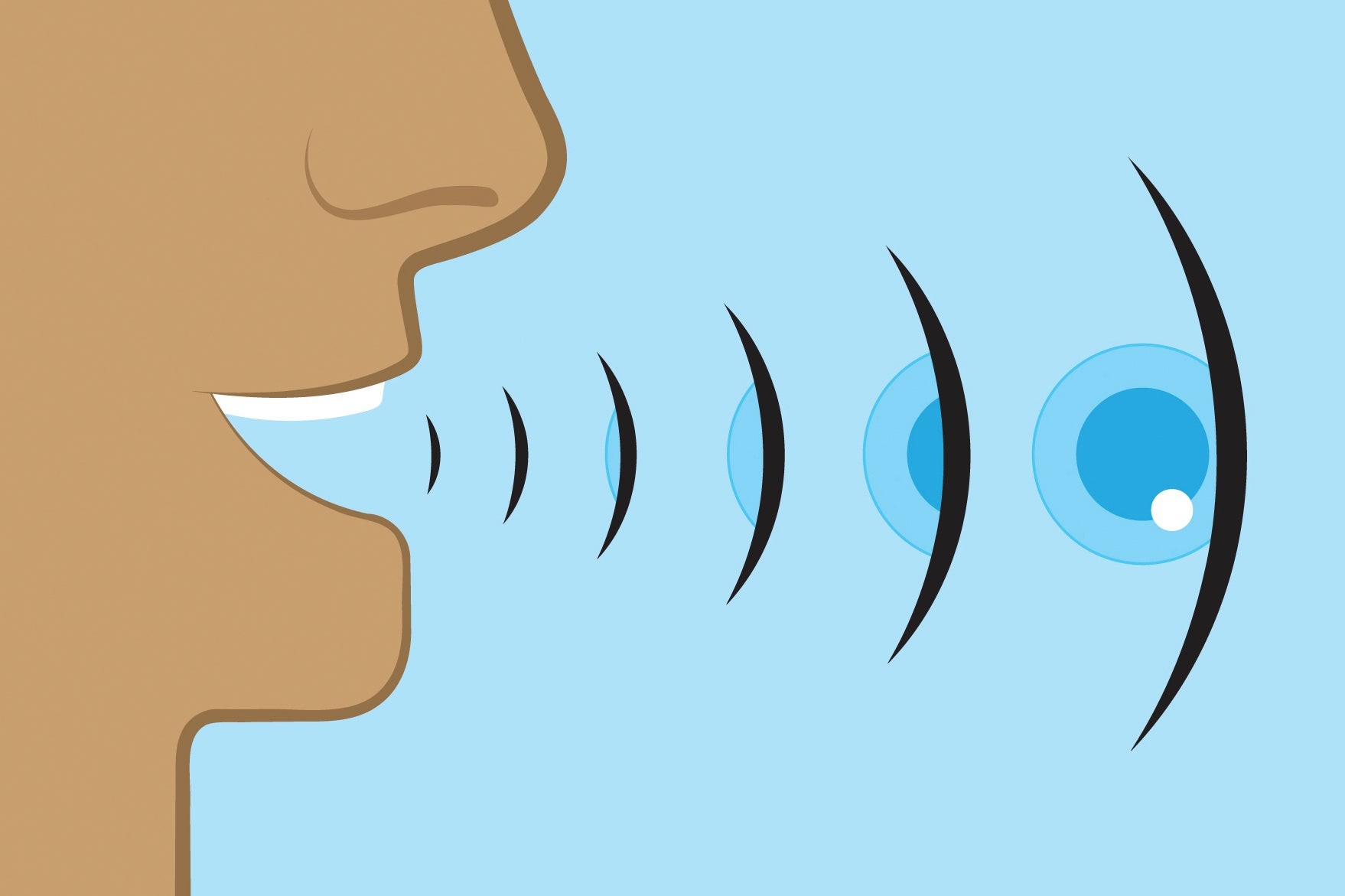Can You Learn Echolocation? Absolutely, you can! LEARNS.EDU.VN reveals that human echolocation, the ability to perceive the environment through sound, is a trainable skill for both sighted and blind individuals, leading to remarkable brain plasticity. Master this skill to navigate your surroundings and enhance your spatial awareness.
Let’s explore the depths of echolocation and how it can transform your perception.
1. What is Echolocation and How Does it Work?
Echolocation is the process of using sound waves and their echoes to determine the location and characteristics of objects. Many animals, such as bats and dolphins, use echolocation to navigate and hunt in their environments. But can humans learn this skill too?
1.1 How Animals Use Echolocation
Animals like bats emit high-pitched sounds and then listen for the echoes that bounce back from objects in their surroundings. By analyzing the time delay, intensity, and frequency changes of these echoes, they can create a detailed “sound map” of their environment. This allows them to navigate complex spaces and locate prey with remarkable precision. According to a study by the University of Chicago, bats can distinguish between objects as thin as a human hair using echolocation.
1.2 Human Echolocation: A Trainable Skill
While humans don’t naturally possess the biological adaptations for echolocation like bats, studies have shown that we can learn to use sound to perceive our surroundings. This involves creating sounds, such as tongue clicks or tapping, and interpreting the returning echoes.
2. The Science Behind Human Echolocation
The ability of humans to learn echolocation is rooted in the brain’s remarkable capacity for neuroplasticity. Research has shown that with training, the brain can repurpose areas typically associated with vision to process auditory information related to echolocation.
2.1 Neuroplasticity and Sensory Substitution
Neuroplasticity refers to the brain’s ability to reorganize itself by forming new neural connections throughout life. In the context of echolocation, this means that the brain can adapt to use auditory input to perform tasks traditionally associated with vision. This process is known as sensory substitution. A study published in the journal PLoS One found that individuals who are blind from an early age often exhibit increased activity in the visual cortex when processing auditory information, demonstrating the brain’s ability to repurpose these areas for different sensory inputs.
2.2 Brain Regions Involved in Echolocation
Brain-imaging studies have revealed that several brain regions are involved in human echolocation. These include:
- Auditory Cortex: This region is responsible for processing auditory information, including the echoes used in echolocation.
- Visual Cortex: Surprisingly, the visual cortex also plays a crucial role in echolocation, even in sighted individuals. Studies have shown that the visual cortex becomes activated when people use echolocation to perceive their surroundings.
- Parietal Cortex: This region is involved in spatial processing and navigation, helping individuals to create a mental map of their environment based on auditory information.
2.3 Research Findings on Brain Changes
A study led by Lore Thaler at Durham University, published in Cerebral Cortex, found that both blind and sighted individuals who underwent echolocation training showed increased activity in the visual cortex in response to echoes. This suggests that the brain can adapt to use auditory information to create spatial representations, regardless of whether a person has vision or not. The research also found that participants showed increased gray matter density in auditory areas after training.
3. Who Can Learn Echolocation?
One of the most exciting aspects of human echolocation is that it is a skill accessible to a wide range of people, regardless of their visual abilities.
3.1 Echolocation for Individuals Who Are Blind or Visually Impaired
Echolocation can be a valuable tool for individuals who are blind or visually impaired, allowing them to navigate their environment with greater confidence and independence. By learning to interpret echoes, they can detect obstacles, navigate unfamiliar spaces, and even participate in activities like sports and recreation. According to a survey conducted by the Smith-Kettlewell Eye Research Institute, many individuals who are blind or visually impaired report that echolocation has significantly improved their quality of life and independence.
3.2 Echolocation for Sighted Individuals
Interestingly, sighted individuals can also learn echolocation and benefit from the enhanced spatial awareness it provides. While sighted people may not rely on echolocation as heavily as those who are blind, it can still be a useful skill for navigating in low-light conditions, improving spatial perception, and even enhancing athletic performance.
3.3 Age and Learning Echolocation
While children may have a slight advantage in learning echolocation due to their greater neuroplasticity, adults can also acquire this skill with dedicated practice. Studies have shown that individuals of all ages can improve their echolocation abilities through training and consistent effort.
4. Benefits of Learning Echolocation
Learning echolocation can offer a wide range of benefits, both for individuals who are blind or visually impaired and for sighted individuals.
4.1 Enhanced Spatial Awareness and Navigation
Echolocation can significantly improve spatial awareness and navigation skills, allowing individuals to perceive their surroundings in greater detail and move through complex environments with greater confidence. This can be particularly beneficial for individuals who are blind or visually impaired, who may face challenges navigating unfamiliar spaces.
4.2 Increased Independence and Confidence
By providing a means of perceiving the environment without relying on vision, echolocation can increase independence and confidence for individuals who are blind or visually impaired. This can empower them to take on new challenges, participate in a wider range of activities, and live more fulfilling lives.
4.3 Improved Cognitive Abilities
Learning echolocation can also have positive effects on cognitive abilities, such as spatial memory, attention, and auditory processing. The brain’s ability to adapt to new sensory inputs and create spatial representations can enhance cognitive function and improve overall brain health.
4.4 Applications in Sports and Recreation
Echolocation can even be applied in sports and recreation, allowing individuals who are blind or visually impaired to participate in activities like running, cycling, and basketball. By using echolocation to detect obstacles and navigate the playing field, they can enjoy the physical and social benefits of sports and recreation.
5. How to Learn Echolocation: A Step-by-Step Guide
If you’re interested in learning echolocation, here’s a step-by-step guide to help you get started.
5.1 Start with Basic Sound Production
The first step in learning echolocation is to develop the ability to produce consistent and controlled sounds. Most people start with tongue clicks, but you can also experiment with other sounds, such as tapping or snapping your fingers.
5.2 Practice Listening to Echoes in Different Environments
Once you can produce consistent sounds, start practicing listening to the echoes they create in different environments. Begin in quiet, open spaces and gradually move to more complex environments with obstacles and varying surfaces.
5.3 Learn to Discriminate Distances and Object Sizes
As you become more comfortable listening to echoes, start practicing discriminating distances and object sizes. Try to estimate how far away an object is based on the time delay of the echo, and how large it is based on the intensity and frequency changes of the echo.
5.4 Use Virtual Mazes and Real-World Navigation
To further develop your echolocation skills, use virtual mazes and real-world navigation exercises. Virtual mazes can provide a safe and controlled environment to practice navigating using simulated click-plus-echo sounds. Real-world navigation exercises can help you apply your echolocation skills in practical situations.
5.5 Seek Guidance from Experienced Echolocators
Consider seeking guidance from experienced echolocators, who can provide valuable tips, feedback, and support. There are many online communities and organizations dedicated to echolocation, where you can connect with other learners and experts.
 Person Using Echolocation to Navigate
Person Using Echolocation to Navigate
The illustration shows a person using echolocation to navigate, highlighting the concept of sound perception.
6. Echolocation Training Programs and Resources
Several training programs and resources are available to help you learn echolocation.
6.1 Online Courses and Tutorials
Many online courses and tutorials offer structured lessons and exercises to guide you through the process of learning echolocation. These resources often include videos, audio recordings, and interactive exercises to help you develop your skills.
6.2 Workshops and In-Person Training
Workshops and in-person training sessions provide opportunities to learn from experienced instructors and practice your skills in a supportive environment. These events often include hands-on exercises, group activities, and personalized feedback.
6.3 Books and Publications
Several books and publications explore the science and practice of echolocation. These resources can provide valuable insights into the techniques, benefits, and applications of echolocation.
6.4 Organizations Supporting Echolocation Learning
Several organizations dedicated to supporting echolocation learning offer resources, training, and community support. These organizations can connect you with other learners, experts, and advocates for echolocation.
Table: Resources for Learning Echolocation
| Resource Type | Description | Benefits |
|---|---|---|
| Online Courses | Structured lessons, videos, and interactive exercises. | Convenient, self-paced learning. |
| Workshops | Hands-on training sessions with experienced instructors. | Personalized feedback, group activities. |
| Books & Publications | Detailed information on the science, techniques, and benefits of echolocation. | In-depth knowledge, reference material. |
| Support Groups | Connect with other learners and experts for tips, advice, and encouragement. | Community support, shared experiences. |
| Mobile Apps | Interactive tools and games to practice echolocation skills. | On-the-go practice, gamified learning. |
| Assistive Devices | Devices designed to enhance echolocation abilities by amplifying echoes or providing tactile feedback. | Enhanced perception, improved navigation. |
| Expert Instructors | Professional instructors with years of experience in teaching echolocation. | Expert guidance, tailored instruction. |
| Virtual Reality (VR) | Immersive VR environments that simulate real-world scenarios for practicing echolocation skills. | Safe and controlled practice, realistic simulations. |
| Summer Camps | Intensive programs for children and adults to learn echolocation in a fun and supportive environment. | Intensive learning, social interaction. |
| Research Studies | Scientific studies exploring the effectiveness of different echolocation training methods. | Evidence-based insights, optimized training. |
| Echolocation Clubs | Local groups where individuals can meet, practice, and share their experiences with echolocation. | Regular practice, peer support. |
| Online Forums | Discussion boards and forums where learners can ask questions, share tips, and connect with the community. | Q&A, community engagement. |
| Mentorship Programs | Pairing new learners with experienced echolocators for one-on-one guidance. | Personalized support, expert advice. |
| Webinars | Live online presentations and workshops on various aspects of echolocation. | Accessible learning, expert insights. |
| Conferences | Events where researchers, practitioners, and learners gather to share their knowledge and experiences with echolocation. | Networking, knowledge sharing. |
| Podcasts | Audio programs discussing echolocation techniques, interviews with experts, and success stories from practitioners. | Convenient listening, expert interviews. |
| Workshops for Kids | Specialized workshops designed for children with games and activities to learn echolocation skills in a fun and engaging way. | Child-friendly learning, engagement. |
| University Courses | Courses offered at universities that cover the science and application of echolocation in various fields. | Academic rigor, comprehensive knowledge. |
| Government Programs | Government-sponsored programs that provide funding and resources for echolocation training and research. | Financial assistance, program support. |
| Non-Profit Support | Non-profit organizations that offer grants, scholarships, and resources to support echolocation learning and accessibility initiatives. | Financial aid, community support. |
7. Overcoming Challenges in Learning Echolocation
While learning echolocation can be a rewarding experience, it also presents some challenges.
7.1 Patience and Persistence
Learning echolocation takes time and effort, so it’s important to be patient and persistent. Don’t get discouraged if you don’t see results immediately. Keep practicing consistently, and you will gradually improve your skills.
7.2 Finding the Right Learning Environment
Finding the right learning environment can also be crucial for success. Choose quiet, open spaces where you can focus on listening to echoes without distractions. As you progress, gradually introduce more complex environments with obstacles and varying surfaces.
7.3 Dealing with Sensory Overload
In some environments, the abundance of sounds and echoes can be overwhelming, leading to sensory overload. To avoid this, start in simple environments and gradually increase the complexity as you become more comfortable. You can also try using noise-canceling headphones to reduce background noise.
7.4 Staying Motivated
Staying motivated throughout the learning process can be challenging, especially when you encounter setbacks or plateaus. To stay motivated, set realistic goals, track your progress, and celebrate your achievements along the way. You can also connect with other learners and share your experiences and successes.
8. Echolocation in Popular Culture and Technology
Echolocation has captured the imagination of people around the world, and it has been featured in popular culture and technology in various ways.
8.1 Echolocation in Movies and Literature
Echolocation has been portrayed in movies and literature as a superpower, allowing characters to navigate and perceive their surroundings in extraordinary ways. These portrayals often highlight the potential for human adaptation and the power of the brain to overcome limitations.
8.2 Assistive Technology Using Echolocation Principles
Researchers and developers are creating assistive technologies that use echolocation principles to help individuals who are blind or visually impaired. These technologies often use sensors and algorithms to detect obstacles and provide auditory or tactile feedback to the user.
8.3 Potential Future Applications of Echolocation
The potential future applications of echolocation are vast and exciting. Echolocation could be used in various fields, such as robotics, search and rescue, and underwater exploration. By developing more advanced echolocation technologies, we can unlock new possibilities for human perception and interaction with the environment.
9. Ethical Considerations of Echolocation
As with any technology or skill that enhances human capabilities, it’s important to consider the ethical implications of echolocation.
9.1 Privacy Concerns
Echolocation could potentially be used to gather information about people and their surroundings without their knowledge or consent, raising privacy concerns. It’s important to develop guidelines and regulations to prevent the misuse of echolocation technology.
9.2 Accessibility and Equity
It’s important to ensure that echolocation training and technologies are accessible and equitable to all individuals, regardless of their socioeconomic status or geographic location. This requires addressing barriers to access, such as cost, transportation, and language.
9.3 Responsible Development and Use of Echolocation Technologies
As echolocation technologies continue to evolve, it’s important to prioritize responsible development and use. This involves considering the potential impacts on individuals, society, and the environment, and developing guidelines and regulations to mitigate any negative consequences.
10. Inspiring Stories of Echolocation Users
There are many inspiring stories of individuals who have transformed their lives through echolocation.
10.1 Case Studies of Successful Echolocators
Several case studies document the remarkable achievements of individuals who have mastered echolocation. These stories highlight the potential for human adaptation and the power of echolocation to enhance independence and quality of life.
10.2 Personal Accounts of Enhanced Independence and Quality of Life
Many individuals who use echolocation report that it has significantly improved their independence and quality of life. They describe how echolocation has allowed them to navigate unfamiliar spaces with greater confidence, participate in activities they previously thought were impossible, and connect with the world around them in new and meaningful ways.
10.3 Empowering Stories of Overcoming Challenges
The stories of echolocation users are often filled with tales of overcoming challenges and defying expectations. These stories serve as a testament to the human spirit and the power of perseverance.
Echolocation is a remarkable skill that can be learned by anyone, regardless of their visual abilities. By mastering echolocation, you can enhance your spatial awareness, increase your independence, and unlock new possibilities for perception and interaction with the world around you.
Are you ready to embark on your echolocation journey? Visit LEARNS.EDU.VN to discover more resources, courses, and communities to help you master this extraordinary skill. Join the growing community of echolocation enthusiasts and experience the world in a whole new way. Contact us at 123 Education Way, Learnville, CA 90210, United States. Whatsapp: +1 555-555-1212. Website: LEARNS.EDU.VN. Start your journey today! Explore the power of sensory skills and adaptive technology with learns.edu.vn.
FAQ About Learning Echolocation
1. Can anyone really learn echolocation?
Yes, both sighted and blind individuals can learn echolocation with consistent practice and training.
2. How long does it take to learn echolocation?
The time it takes to learn echolocation varies, but many people see noticeable improvements within 10 weeks of regular practice.
3. What are the best sounds to use for echolocation?
Tongue clicks are commonly used, but other sounds like tapping or snapping fingers can also be effective.
4. Is echolocation only useful for people who are blind?
No, sighted individuals can also benefit from enhanced spatial awareness and navigation skills through echolocation.
5. What brain changes occur when learning echolocation?
The brain’s visual cortex can be repurposed to process auditory information, leading to increased activity in auditory and visual areas.
6. Are there any age limitations for learning echolocation?
While children might have an advantage due to neuroplasticity, adults of all ages can learn and improve their echolocation abilities.
7. What resources are available for echolocation training?
Online courses, workshops, books, and supportive organizations offer guidance and resources for learning echolocation.
8. What challenges might I face when learning echolocation?
Challenges include patience, finding the right environment, sensory overload, and staying motivated.
9. How can echolocation improve my quality of life?
Echolocation can enhance independence, spatial awareness, and participation in sports and recreational activities.
10. Are there ethical considerations for using echolocation?
Yes, privacy concerns, accessibility, and responsible development of echolocation technologies are important ethical considerations.

